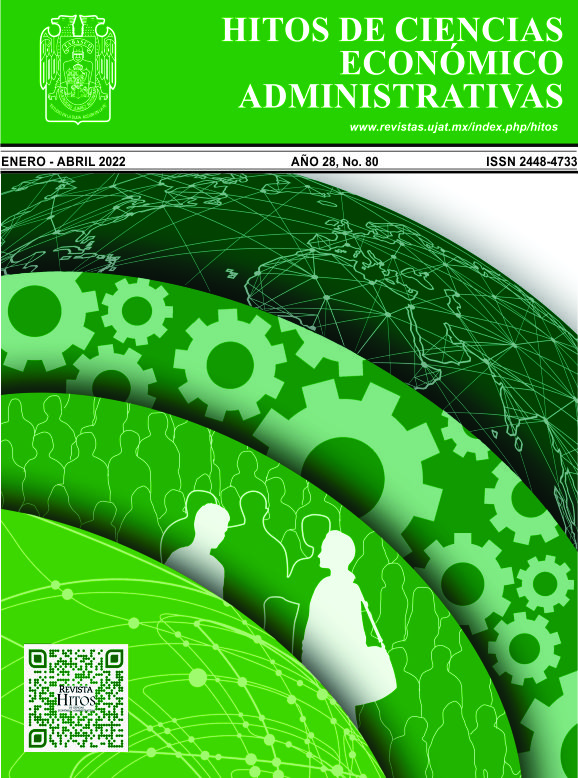Índice de cohesión organizacional: Propuesta para evaluar la guía corporativa
DOI:
https://doi.org/10.19136/hitos.a28n80.4883Keywords:
Índice de cohesión organizacional, Gestión empresarial, Administración estratégica, Marco filosófico de la empresa.Abstract
OBJETIVO: Presentar y desarrollar una metodología objetiva y confiable para obtener información en cuanto al sentido compartido de la esencia de la Visión, Misión y Valores en una organización.
MATERIAL Y MÉTODO: Enfoque mixto debido a la parte cualitativa de la valoración subjetiva de los resultados obtenidos en primera instancia y cuantitativa. Alcance exploratorio, debido a que sustenta la aplicación de la metodología y los resultados obtenidos a las empresas, que en 2019 se intervino no estableciendo un universo geográficamente delimitado y; por lo tanto, tampoco una muestra representativa.
RESULTADOS: Se presentan análisis tanto individual como grupal para cada una de las 20 empresas, y para cada apartado (Visión, Misión y Valores) se hizo el correspondiente análisis y discusión de resultados, dada la extensión de esto se pone uno a manera de ejemplo y posteriormente un resumen global de las 20 empresas.
CONCLUSIONES: Es posible aplicar el Índice de Cohesión Organizacional para determinar el valor que la guía y la cohesión le dan al conjunto de percepciones que sobre estas áreas se tiene en la empresa y sobre esta base generar estrategias de intervención para corregir, prevenir o mejorar este índice.
Downloads
References
Celaya-Figueroa, R. & López, J. N. A. (2005). El enfoque de competencias en la docencia. Revista Escuela de Administración de Negocios, (54), 39-57. https://journal.universidadean.edu.co/index.php/Revista/article/view/332/323
Celaya-Figueroa, R. (2014). Administración Trascendental. PYME Adminístrate Hoy, 21(242).
Celaya-Figueroa, R. (2015). Cono-ciencia: La revolución necesaria en nuestras universidades para dinamizar la construcción de una sociedad mejor. ITSON.
Chavenato, I. (2004). Introducción a la teoría general de la administración (7ª ed.). McGraw-Hill Interamericana.
Corporate Excellence. (2011). Misión, visión y valores de la empresa: en el centro de una buena praxis de la RSC. http://www.corporateexcellence.org/index.php/content/download/2461/ 25880/file/I07%20Misi%C3%B3n%20Visi%C3%B3n%20y%20valores%20en%20el%20centro%20de%20una%20buena%20praxis%20de%20la%20RSC.pdf
Drucker, P. F. (1955). The management horizon. The Journal of Business, 28(3), 155-164. https://www.jstor.org/stable/2350816
Drucker, P. F. (2012). Managing in a time of great change. Routledge. https://doi.org/10.4324/9780080938752
García, J. y Pulgar, N. (2010). Globalización: aspectos políticos, económicos y sociales. Revista de Ciencias Sociales, 16(4). http://ve.scielo.org/scielo.php?script=sci_arttext&pid=S1315-95182010000400014&lng=es&tlng=pt.
Mangani, F. R. (2013). Administración general. Facultad de Ciencias Económicas. Universidad de Buenos Aires.
Martínez-Ferrer, G. (2009). Definiendo el negocio, en Estrategia: del análisis a la implementación, para que no quede guardada en el cajón. Buenos Aires.
Miles, R. E., Snow, C. S., Mathews, J. A., Miles, G. & Coleman, H. J. (1997). Organizing in the knowledge age: Anticipating the cellular form. The Academy of Management Executive, 11(4), 7-20. https://doi.org/10.5465/ame.1997.9712024836
Nonaka, I. & Takeuchi, H. (1995). The knowledge-creating company: How Japanese companies create the dynamics of innovation. Oxford university press.
Nonaka, I. & Takeuchi, H. (2007). The knowledge-creating company. Harvard business review, 85(7/8), 162. https://memberfiles.freewebs.com/84/90/65819084/documents/The%20 Knowledge-Creating%20Company.pdf
Oliveira-Da Silva, R. (2002). Teorías de la Administración. Thomson Editores.
Robbins, S. y Coulter, M. (2005). Administración (8ª ed.). Pearson Educación.
Steiner, G. A. (2007). Planeación estratégica: Lo que todo director debe saber. Grupo Editorial Patria.
Terán, K., Robles, J. M., Preciado, J. M. & López, D. C. (2019). Equidad gerencial, como una demanda intangible de mercado: hacia organizaciones sustentables. Entre Ciencia e Ingeniería, 13(26), 85-93. https://doi.org/10.31908/19098367.1166
Valdés, A. H. (1999). Procesos para establecer Objetivos de la Planeación Estratégica. Revista Contaduría y Administración. Abril – junio 1999. www.ejournal.unam.mx/rca/193/RCA 19307.pdf
Downloads
Published
Issue
Section
License
Copyright (c) 2021 Universidad Juárez Autónoma de Tabasco

This work is licensed under a Creative Commons Attribution-NonCommercial-ShareAlike 4.0 International License.
As a requirement for the manuscript, the author is requested to provide the Copyright Assignment Letter, so that the Journal has the publication rights and to avoid plagiarism.
PLAGIARISM POLICIES
The Editorial Board of the Journal HITOS DE CIENCIAS ECONÓMICO ADMINISTRAIVAS has the authority to reject in the review process any manuscript that does not have adequate citation in the documents consulted in its scientific research work, which can be considered as plagiarism behaviors. Likewise, the referees carry out the plagiarism review using specialized software, such as iThenticate, among others.
COPYRIGHT POLICIES
Authors who have publications in the journal accept the following terms: • At the time the manuscript is accepted, the author transfers the copyright to the Journal HITOS DE CIENCIAS ECONÓMICO ADMINISTRATIVAS.
- The authors may make additional agreements for non-exclusive distribution of the published version of the article (e.g., including it in an institutional repository or publishing it in a book) provided that the initial publication in this journal is indicated.
- Authors are allowed and recommended to publish their research work on the Internet (eg, institutional or personal files), which would allow more beneficial exchanges to increase the citation of the published work.
This work is licensed under Creative Commons Attribution-NonCommercial-NoDerivatives 4.0 International





